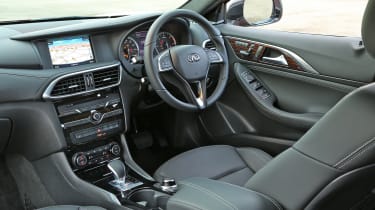Infiniti Q30 review - Japanese premium compact takes on German rivals - Infiniti Q30 interior and tech
Not a car to make you grin on a twisty road, but ride and refinement are both Q30 trump cards
The Q30’s cabin is really quite pleasant. That’s thanks in no small part to an abundance of Mercedes-Benz components – on a rough count, almost all of the switchgear, the pedals, the basic steering wheel design, instruments, TFT instrument display, gear selector and the key are all sourced from the German firm.
But the cabin design itself is unique to Infiniti and certainly none the worse for it. The dashboard is perhaps a little more generic in its forms than the A-class, but with an integrated infotainment display it does avoid the “fake iPad” look of the Merc’s floating screen. The materials used have a premium feel too – notably the Alcantara-trimmed (and purple stitched) dashboard trim, metallic accents and soft leather steering wheel rim.
It’s not faultless, however. While there’s decent adjustment to the driver’s seat the squab feels quite short, and there’s definitely a slightly perched feel to the taller cabin than you get in an A-class. Some drivers will like that of course (and the short squab will suit smaller drivers) but it does detract from any sporty feel the Q30 might otherwise have. Another issue is visibility - thick pillars and narrow glass apertures give an enclosed feel to the cabin and hinder your view through corners.
Infiniti’s InTouch infotainment screen leaves something to be desired too. Theoretically simple functions like changing music tracks should have large, clear buttons on-screen, but instead you must use a small physical button on the centre console that feels illogically-placed far from your reach. The steering wheel buttons don’t help, as they only operate the central instrument screen. The infotainment screen does also seem rather small by modern standards.





